Archive for the ‘Asia’ Tag
Monday, August 7: Leaving Osaka Garden Palace, I walk a half mile in the pouring rain, lugging my suitcase behind me, to Shin-Osaka Station. Last night, I bought an 8:40 a.m. ticket for the Shinkansen, to arrive in Tokyo at 11:13 this morning. Since I get to the station early, I stop at Tully’s Coffee for a breakfast snack and coffee, sharing a table with a British couple traveling around Japan. We have a nice chat about our travels, and then I’m on my way.
All the way on the Shinkansen, news about the typhoon is flashing on the screen at the front of the car. I read on my phone that the worst parts of the storm are behind us, with some flooding and road closures, and I keep hoping that I’ll make it to Tokyo before the typhoon puts the brakes on the trains.
Luckily, I make it to Tokyo right on schedule, where I get on the Yamanote Line at Tokyo Station at 11:23, arriving at Nippori Station at 11:38. There, after some confusion, I take the Keisei Line for another hour to Keisei-Narita Station, where I get off and catch a taxi to my hotel, Ryokan Wakamatsu Honten. Though it’s too early to check in, I leave my bag and head out. By now, it’s about 1:40. I go in search of a restaurant for lunch, finding a nice spot where I order a sushi set meal.

sushi restaurant in Narita

sushi
The Ryokan Wakamatsu Honten is directly across the street from Narita’s biggest temple, Naritasan Shinshoji Temple.

Ryokan Wakamatsu Honten
My first piece of business is to withdraw the rest of my money from my Japan Post account, so I head down Omotesando Street in search of an ATM.
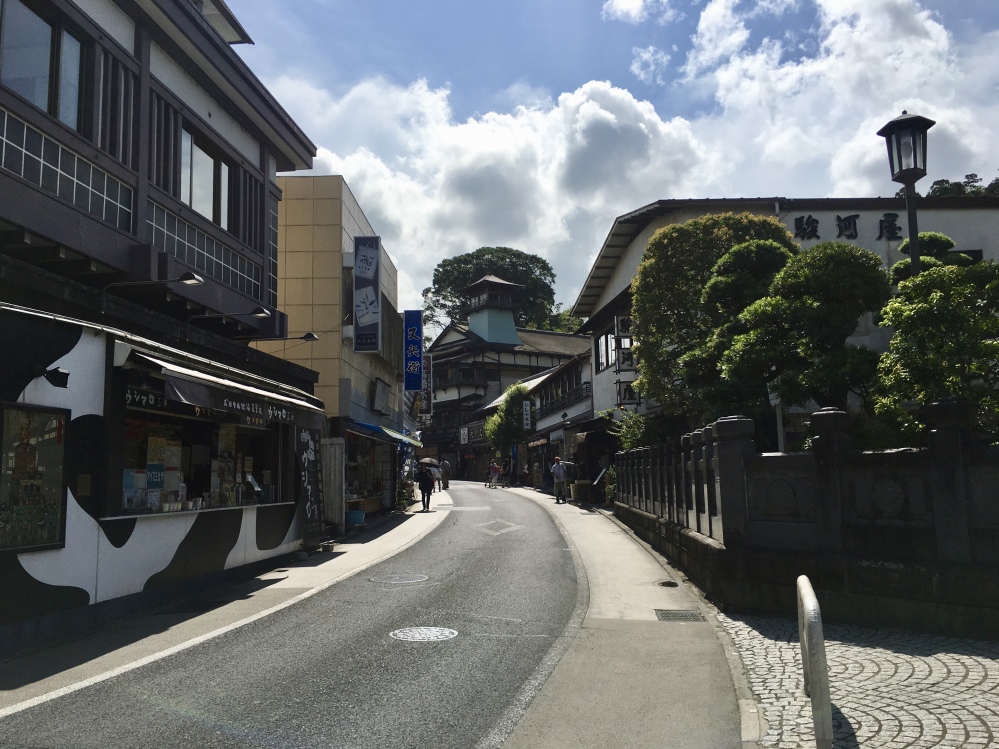
Omotesando Street
After withdrawing all remaining yen from my account, I head to Naritasan Shinshoji Temple, where I admire the impressive 2007 Somon Gate. On the upper story of this main gate, eight different Buddha images representing different birth years are enshrined to protect all people.
Naritasan Shinshoji Temple belongs to the Chisan Sect of Shingon Buddhism. The image of Fudō Myō-ō, “Unmovable Wisdom King,” the main deity of the temple, is historically significant in that Kobo Daishi (or Kukai, the founder of Shingon Buddhism) is said to have carved, consecrated and conducted a Goma ritual before this very statue in 810, by order of the 52nd emperor of Japan, Emperor Saga (786 – 842).
In 939, when a revolt led by Taira no Masakado threw the nation into chaos, the 61st emperor of Japan, Emperor Suzaku (923 – 952), secretly ordered Archbishop Kanjo, a Buddhist priest of the highest order, to carry this Fudō Myō-ō image, which had been enshrined at a temple in Kyoto, to the Kanto area battlefield to suppress the rebellion. Here at Narita, Kanjo conducted a Goma rite in front of the image lasting 21 days, praying for the sake of peace. On February 14, 940, the final day of the Goma prayer, the revolt was suppressed and Naritasan was founded to commemorate the victory.
The temple is famous for its Goma ritual, where many votive offerings are dedicated in front of the Fudō Myō-ō and special wooden Goma sticks are burnt on the altar. The fire of the Goma rite symbolizes the wisdom of Fudō Myō-ō, and the wooden Goma sticks represent the afflictions of human beings. By burning the Goma sticks, which have been inscribed with the human afflictions in the fire of Fudō Myō-ō’s wisdom, the officiating priest prays with the devotees that their afflictions might be removed (from the temple pamphlet).

Somon Gate
The 1831 Niomon Gate enshrines the four guardians of the Buddha-Misshaku-kongo on the right and the Naraen-kongo on the left in the front, and Komoku-ten and Tamon-ten in the back.

walkway to Niomon Gate
As with all Japanese temples, there is a water purification area where visitors should cleanse themselves before entering the temple grounds.

water pavilion
The huge red lantern at Niomon Gate is impressive in its size.

Niomon Gate

Lantern at Nioman Gate

Nioman Gate

lantern at Nioman Gate

straw sandals at Nioman Gate

lantern at Niomon Gate

straw sandals at Nioman Gate
Niomon Gate’s lantern is quite beautiful.

lantern at Niomon Gate
Adjacent to the Niomon Gate is Nio-ike pond, where people can release live fish symbolizing the Buddhist teaching of nonviolence, or the belief in the sacredness of all living creatures. A rock in the pond is covered with a congregation of small turtles.

Pond with turtles around Niomon Gate

around Niomon Gate

around Niomon Gate
There are many halls and buildings on the grounds of Naritasan Shinshoji Temple.

Naritasan Shinshoji Temple

Naritasan Shinshoji Temple
The 1712 Three Storied Pagoda enshrines five Buddhas, and reliefs of 16 Buddhist saints are carved on the inner wooden walls.

Three Storied Pagoda

Three Storied Pagoda
The Three Storied Pagoda here has magnificent ornamentation and vivid colors.

Three Storied Pagoda
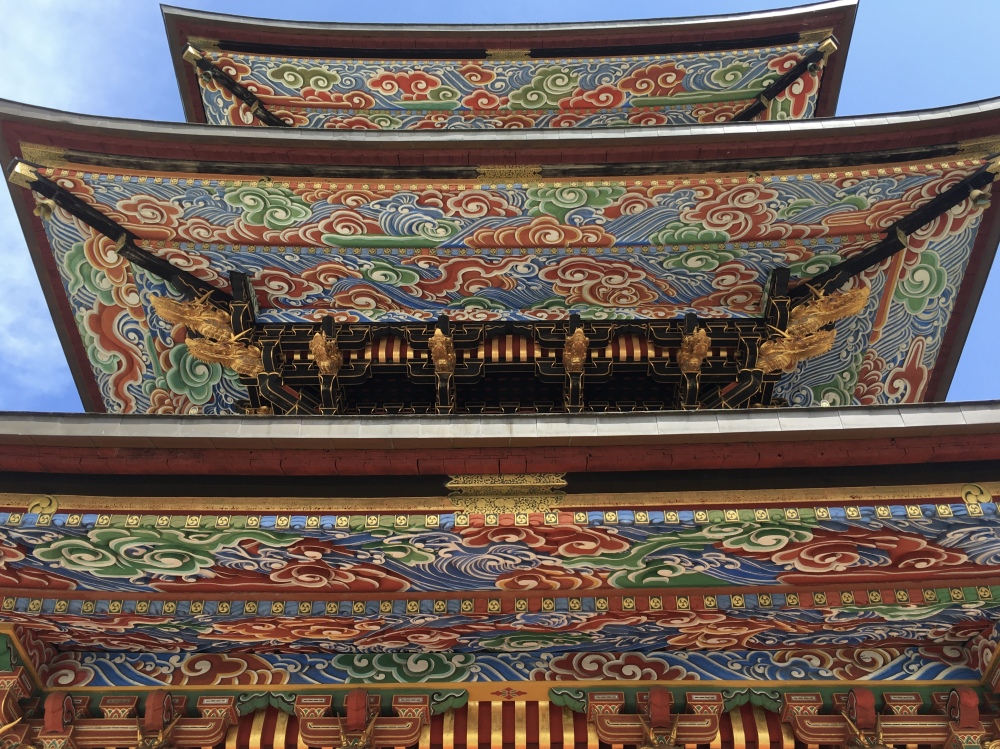
Three Storied Pagoda

Three Storied Pagoda
The Great Main Hall, built in 1968, is where the most important Goma ritual is performed in front of the Fudō Myō-ō image, along with the Four Messengers. I’m lucky enough to attend this ritual as they hold one at 3:00. It goes for about a half hour, with the head priest and other monks chanting and throwing wooden sticks into a fire. It’s miserably hot today, so though the ritual is fascinating, it’s an uncomfortable 30 minutes.

Great Main Hall

Great Main Hall
After the Goma ritual, I go out to explore the rest of the grounds. The Shotoku-taishi-do (or Prince Shotoku Hall) was built in 1992.

Shotoku-taishi-do

Shotoku-taishi-do

ema at Shotoku-taishi-do

ema at Shotoku-taishi-do

lanterns around Shotoku-taishi-do
Prince Shotoku (572-622 AD) is considered the “Father of Japanese Buddhism.” This hall was erected with the hope of realizing world peace based on the Prince’s ideal: “Harmony should be valued among people.”
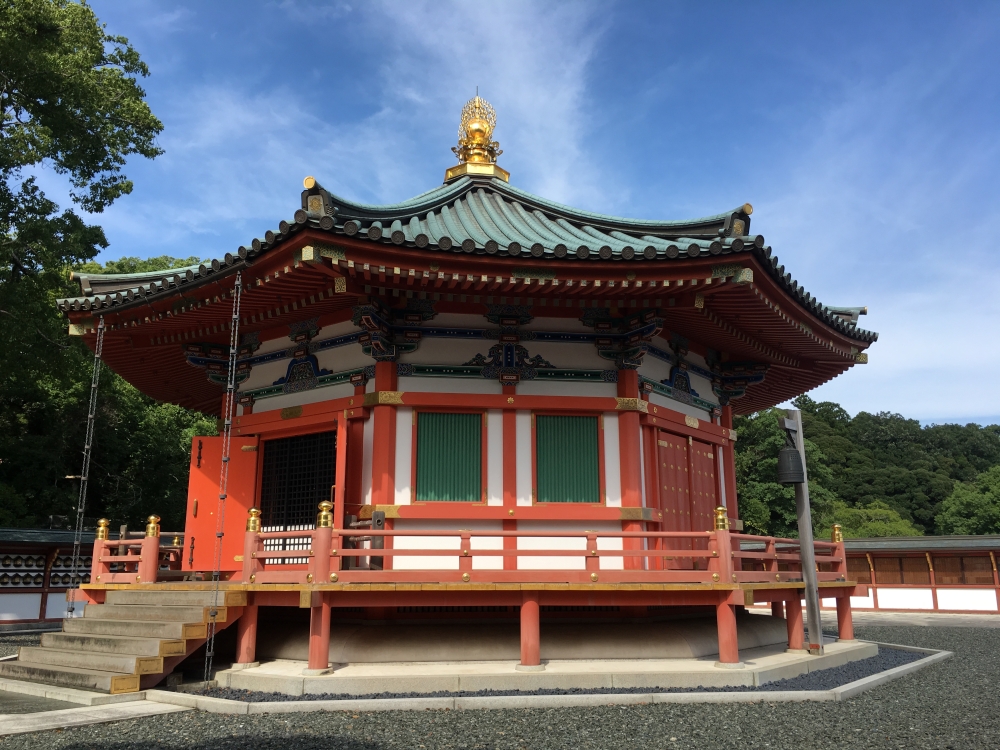
Shotoku-taishi-do
Naritasan Shinshoji Temple of course has its own unique ema.

ema at Naritasan Shinshoji Temple

ema at Naritasan Shinshoji Temple
Shaka-do Hall, built in 1858, was previously used as the main hall. Enshrined within are Sakyamuni Buddha in the center, and four bodhisattvas. The reliefs of 500 Buddhist saints and 24 paragons of Filial Piety are carved in the walls.

Shaka-do Hall

Shaka-do Hall

inside Shaka-do Hall

ema at Shaka-do Hall
Shoutendo Hall enshrines the secret Buddha statue of the temple, Daisyo Kangiten. Every first week of the month, a special prayer is performed by a priest. This hall was rebuilt in 2008 as the 1070th anniversary of the temple’s opening.

Shoutendo Hall
Naritasan Park was originally completed in 1928, and redesigned in 1998. It covers some 165,000 square meters. A large pond, waterfall, and fountain enhance the natural beauty of the park.

Naritasan Park

map of Naritasan Park

Naritasan Park

Naritasan Park

Naritasan Park

Naritasan Park

Naritasan Park

Naritasan Park

Naritasan Park

Naritasan Park

Naritasan Park
Besides a great array of tombstones in Naritasan Park, the pond has a pavilion and stone lanterns.
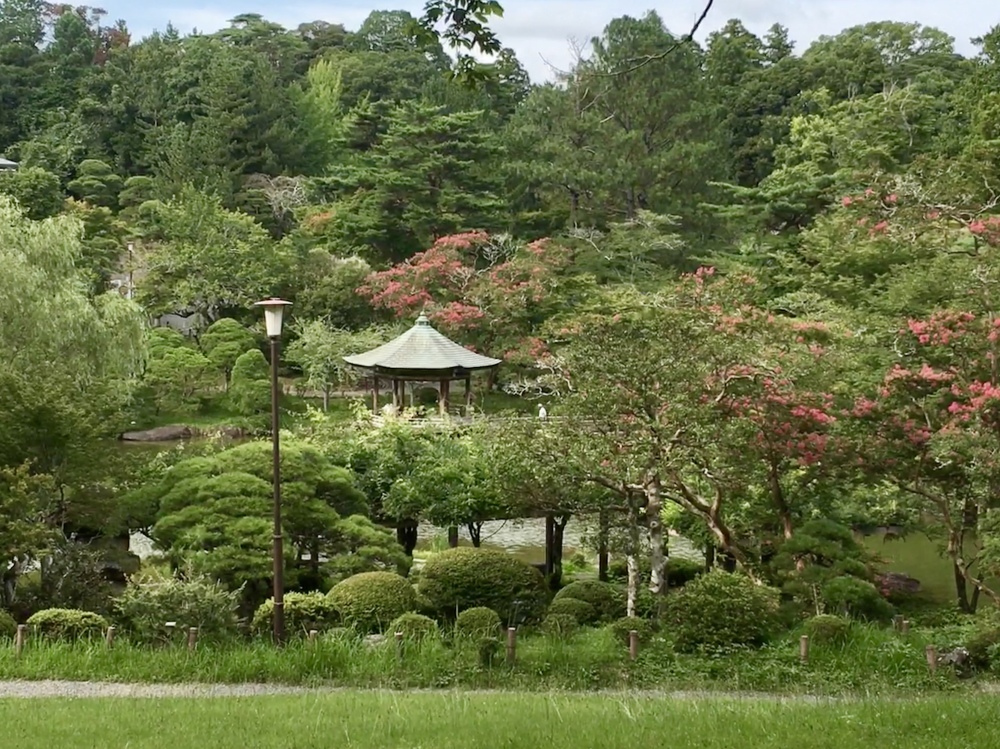
pavilion at Naritasan Park

Naritasan Park

Cool character at Naritasan Park

pavilion at Naritasan Park

Naritasan Park

stone lantern

pond at Naritasan Park
The Naritasan Museum of Calligraphy is on the grounds of the park, but it is closed by the time I get here.

The Naritasan Museum of Calligraphy
I continue my walk through Naritasan Park, sweating profusely in the heat and humidity.

Naritasan Park

Naritasan Park

Naritasan Park

path through Naritasan Park
The 58-meter high Great Pagoda of Peace symbolizes the teaching of Shingon Buddhism. The pagoda enshrines multiple Buddhas and has historical exhibitions about Naritasan, as well as a room for copying the Buddhist scriptures in traditional Japanese calligraphy.
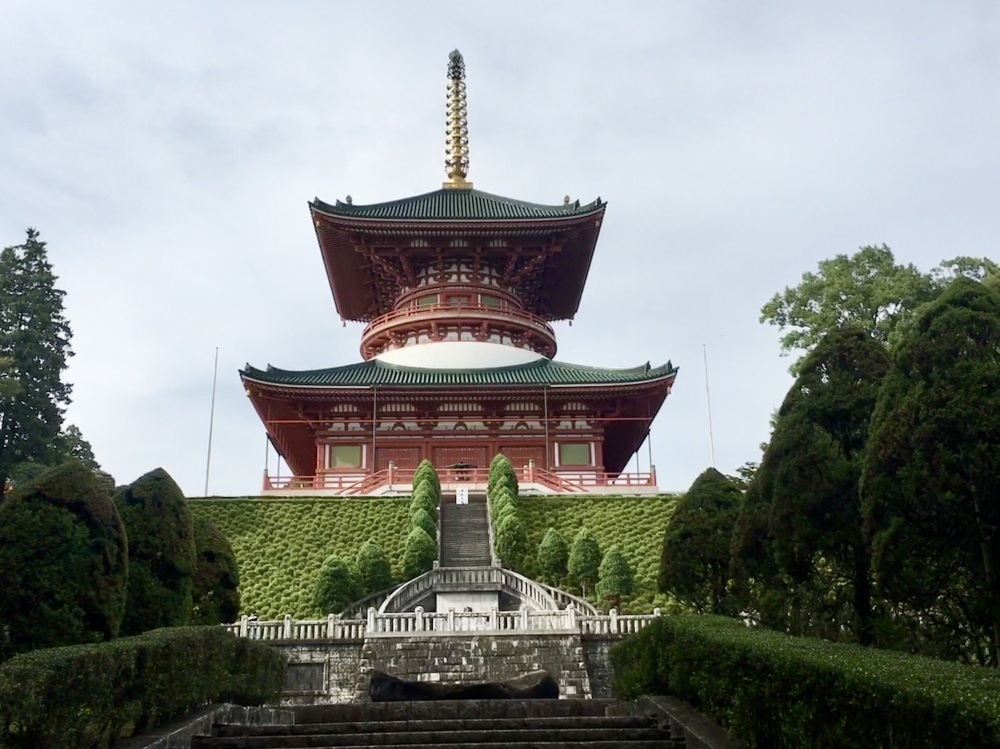
The Great Pagoda of Peace

The Great Pagoda of Peace

The Great Pagoda of Peace

Pond and stone at The Great Pagoda of Peace

The Great Pagoda of Peace

The Great Pagoda of Peace
Past the Great Pagoda of Peace is a group of other halls, including Seiryu-Gongen-do Hall, originally built in 1732 as the guard of the Naritasan Shinshoji temple. This hall enshrines two guardians, Seiryu Gongen and Myoken.

Seiryu-Gongen-do Hall
Komyo-do Hall, 1701, was originally built as the Main Hall. It is a significant and colorful structure from the middle-Edo period. Enshrined here are Dainichinyorai Buddha in the center, Fudō Myō-ō on the right side, and Aizen-Myō-ō on the left side.
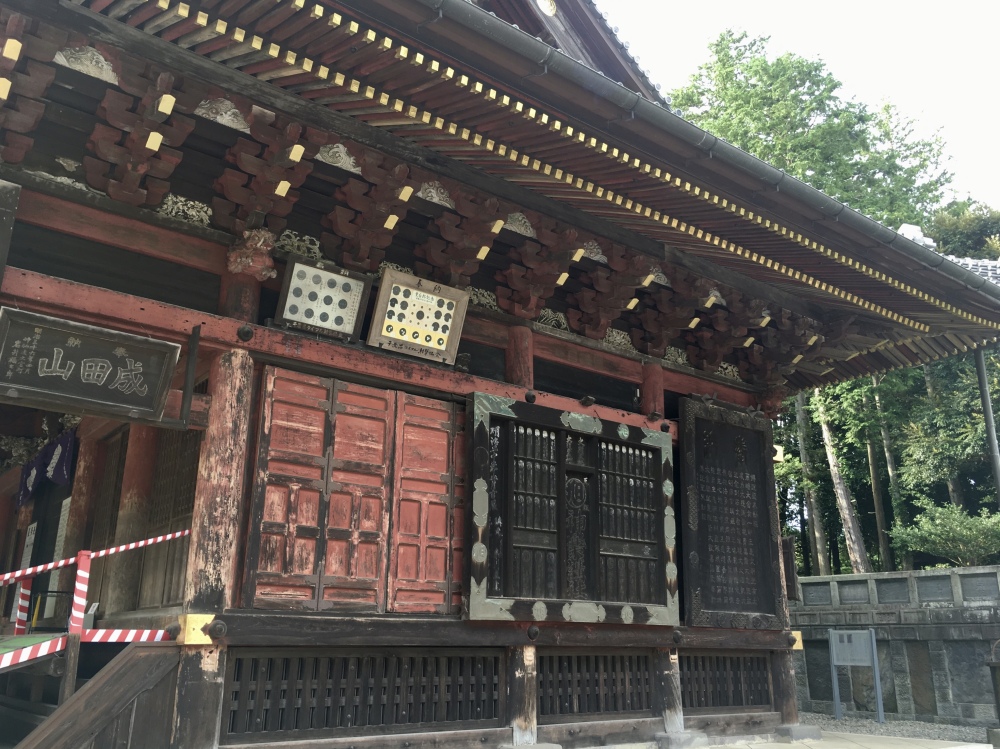
Komyo-do Hall
Okuno-in Cave is 11 meters deep and enshrines Dainichi Nyorai. The door is left open during the Gion Festival from 7th-8th July. One of the stone slabs affixed to the entrance bears an inscription dated 1336.

Komyo-do Hall

ema at Komyo-do Hall

at Komyo-do Hall

Okuno-in Cave
Sanja Shrine consists of three shrines, which are, from left to right, Hakusan Myojin Shrine, Konpira Daigongen Shrine and Imamiya Shrine.

Sanja Shrine
Kaizando Hall enshrines Kanjo, who founded the Naritasan Shinshoji Temple in 940. The hall was built in 1938 commemorating the 1,000th anniversary of the temple

Kaizando Hall
Gaku-do Hall (1861) displays votive tablets (votive pictures of horses and the like) dedicated by devotees. The Hall contains a large stone image of Ichikawa Danjuro VII (famous kabuki actor) and the “Giant Bronze Globe (built in 1907).”

Gaku-do Hall

Gaku-do Hall
After my long and exhaustive walk around the sprawling temple, I return to my room at Ryokan Wakamatsu Honten, where I relax after soaking in the onsen. It’s nice and cool in my room and it feels good to have the sweat washed away.

My room at Ryokan Wakamatsu Honten

phone in my room

My room at Ryokan Wakamatsu Honten
My Ryokan is directly across the street from Naritasan Temple and I have an excellent view from my window of Daishi-do Hall and Korinkaku Hall.

view from my window of Daishi-do Hall and Korinkaku Hall at Naritasan Temple
After a while, I go out to search for dinner, stopping first to take a parting shot of the Somon Gate in the blue light.

Somon Gate in blue light

Naritasan
By this time of night, the old town is quite deserted and I have to walk a long way to find an Indian restaurant where I can enjoy a meal.

Omotesando Street

Omotesando Street

Omotesando Street
Tuesday, August 8: In the morning, I take an early taxi to Narita Airport, where I have a 10:40 a.m. flight to Dallas/Fort Worth airport. However, we sit on the runway for over an hour because Alaska’s tiny Bogoslof volcano erupted, sending an ash cloud about 6 miles into the sky. As a “red” aviation warning was issued, we couldn’t take off until a new flight path was charted.
We took off over an hour late, so I knew before we left the ground that it was unlikely I would catch my connecting flight home to Virginia.
After an 11 hour and 45 minute flight, I arrive in Dallas at 9:50 a.m. on the same day, August 8, earlier than I left. I always find this amusing when traveling home from Asia.
However, because of our late departure from Tokyo, by the time I disembark from the plane in Dallas, I’ve missed the boarding time for my connecting flight. It turns out I will get on a later flight to Dulles Airport, a more convenient airport to my Virginia home than BWI, where I was originally scheduled to land.
Because I have extra time to kill in Dallas, I enjoy a Mexican lunch at the airport, as I won’t arrive home until dinnertime.

lunch in Dallas
Finally, after a three-hour and 12 minute flight, I’m back home, and my Japan adventure has come to an end.
It has been a great adventure, a whirlwind really, and I feel a bit despondent that it’s all over. 😦
Friday, August 4: This morning, my second day in Nara, I take bus #70 for 20 minutes to two temples south of Nara proper: Toshodaiji Temple and Yakushiji Temple.
Toshodaiji Temple is the headquarters of the Ritsu Sect of Buddhism. It was established in 759 when the Chinese priest Ganjin Wajo (688 to 763), a high Buddhist priest of the Tang Dynasty, opened what was originally called Toritsushodai-ji Temple to help people learn the Buddhist precepts. He was invited by Japanese Buddhists studying in China to teach the Imperial Court about Buddhism. In 753, overcoming the hardship of losing his eyesight, he arrived in Japan during his sixth attempt to cross the ocean.

Toshodaiji Temple
The Kondo (Golden Hall or Main Hall) houses the principal seated Rushana Buddha, the standing Yakushi Tathagata statue and the standing Thousand Armed Avalokiteshwara National Treasure.

Kondo (Golden Hall or Main Hall) at Toshodaiji Temple
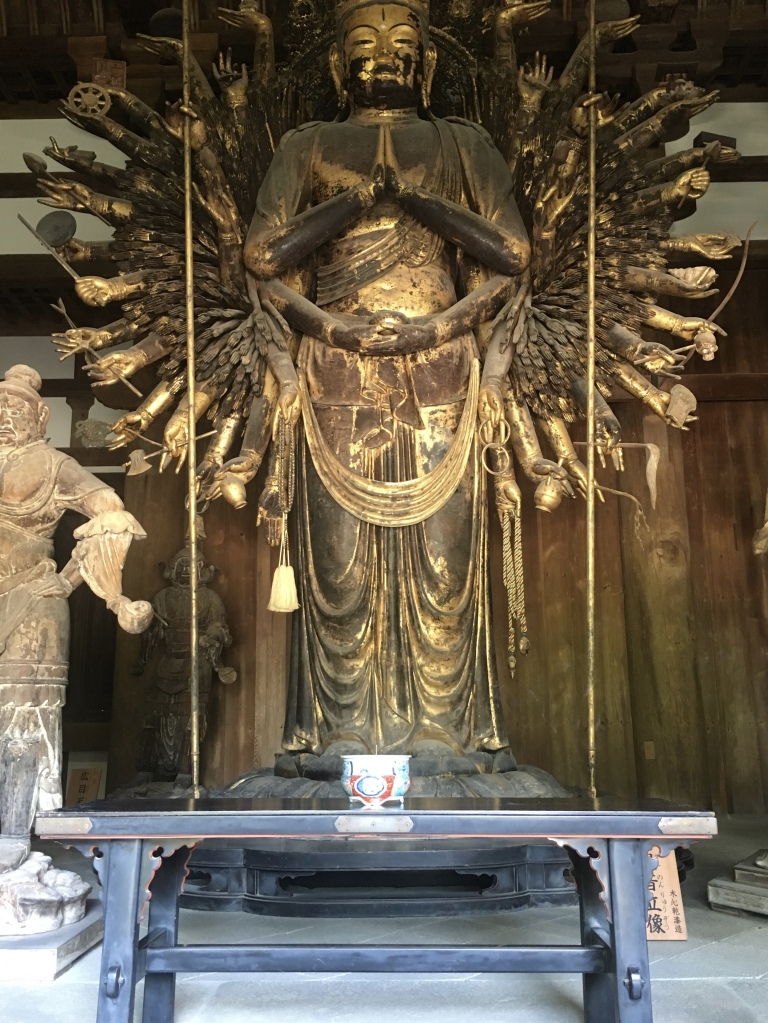
Thousand Armed Avalokiteshwara National Treasure
Photography isn’t allowed inside the halls, but below are three postcards of the Buddhas at Toshodaiji Temple. Click on any image for a full-sized slide show.

Thousand Armed Avalokiteshwara National Treasure

Rushana Buddha

Toshodai-ji
The Kondo, from the 8th century (Nara era) at Toshodaiji Temple is simple, but elegant, as are most Japanese temples.

Kondo (Golden Hall or Main Hall)
The Koro (Multi-storied building) from the 13th century (Kamakura era) is also called “Shariden (reliquary hall) because Buddha’s ashes brought by Ganjin Wajo were enshrined here. In the Zushi (miniature shrine) within the building, the Kinki (golden tortoise) is enshrined. This is also a National Treasure.

Toshodaiji Temple
The Rye-do (Chapel), from the 13th century, was originally the sleeping quarters for monks and is an important cultural property.

Rye-do (Chapel)
The Kodo (Lecture Hall) is from the Nara era. It is a building removed from the Heijo Palace and reconstructed, where the principal seated Maitreya Tathagata statue (important cultural property), the standing Jikoku-ten statue, and the standing Zojo-ten statue are enshrined. It’s another national treasure. I don’t have any pictures of these magnificent statues, sadly, as photography is not allowed.

Kodo (Lecture Hall)

Toshodaiji Temple

Toshodaiji Temple

Toshodaiji Temple

Toshodaiji Temple
A path leads through Toshodaiji Temple to another leafy path.

walkway at Toshodaiji Temple
It’s a welcome relief to find some shade on this hot and sultry day.

path at Toshodaiji Temple
At the end of the path, I find a lovely moss garden with dapples and shadows.

moss garden at Toshodaiji Temple
At the far end of the moss garden is the Kaizan Gubyo, or the Grave of Ganjin, the Founder of Toshodaiji Temple.

Grave of Ganjin, the Founder of Toshodaiji Temple

moss garden at Toshodaiji Temple

moss garden at Toshodaiji Temple

moss garden at Toshodaiji Temple

moss garden at Toshodaiji Temple

lantern at Toshodaiji Temple

moss garden at Toshodaiji Temple

moss garden at Toshodaiji Temple
Toshodaiji Temple is far from Nara proper and its crowds, so it is quite serene here.

Toshodaiji Temple

the Kondo of Toshodaiji Temple
On the way to the Kaidan (ordination platform), a garden of lotus blossoms beckons.

Toshodaiji Temple

gate to Kaidan (ordination platform)

Kaidan (ordination platform)

lotus at Toshodaiji Temple

lotus at Toshodaiji Temple
Toshodaiji Temple has a few beautiful lotus blossoms, even in the heat of the day.

lotus at Toshodaiji Temple

lotus at Toshodaiji Temple

bell at Toshodaiji Temple

Toshodaiji Temple
In looking at my map of these two temples, which are close to each other, I decide instead of taking the bus, I’ll walk to Yakushiji Temple. Though the map says it’s only a half kilometer, it seems longer than that, especially in this heat.
Yakushiji is the headquarters of the Hosso sect of Japanese Buddhism. The actual founder of the Hosso sect is Jion Daishi, but much of the Hosso Sect descends from the “Yugayuishiki” (Yogacara) teachings of Hsuan Tsang (600-664), a famous priest in the T’ang era in China. He studied Buddhism for 17 years in India. After returning to China, he translated 1,335 volumes of important Buddhist writings, and then taught them as well.
Yakushiji was planned around 680 by Emperor Temmu to pray for the recovery of his Empress from a serious illness. During the long construction period, Temmu died and his Empress acceded to the throne and was called Jito. The dedication ceremony for enshrining the chief Buddha, Yakushi Nyorai (the Buddha of Healing or Medicine Buddha) was held in 697. The entire compound was completed in 698 in the south part of Nara, in the Fujiwara Capital. Ten years later, the Capital was moved to the north of Nara (in 710) and Yakushiji was moved to its present site in 718. It is now a UNESCO World Heritage Site.

Yakushiji Temple
Yakushiji was burnt down and destroyed by fires, wars, or natural disasters several times. The most damage was caused by the civil war in 1528. Today only the Yakushiji Triad in the Kondo, the Sho-Kannon in the Toindo and the East Pagoda recall the grandeur of its original features.
Today, sadly, some major parts of the compound are under construction.
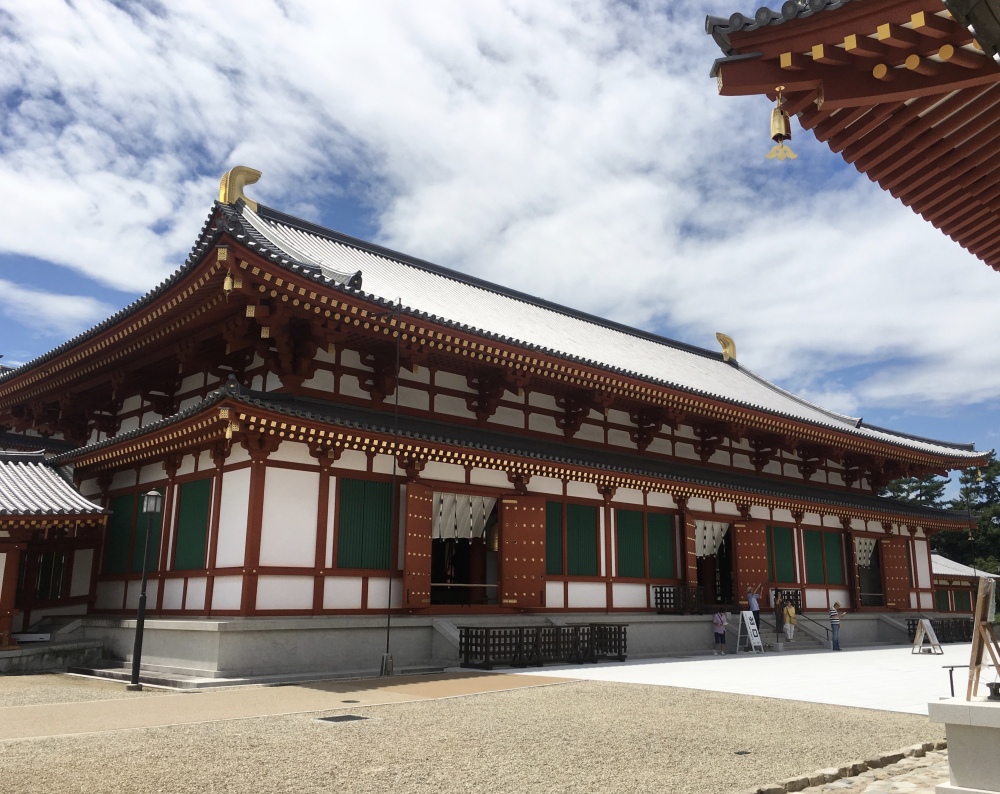
Kodo, or Great Lecture Hall, at Yakushiji Temple

Kondo, or Golden Hall, at Yakushiji Temple
Sadly, because no photography is allowed of the famous Buddha statues, I purchase a couple of postcards of the images. Neither the postcards, nor any photos, could do them justice, as they are imposing and sit within the beautiful Kondo, or Golden Hall. Between the Buddha statues at Toshodaiji Temple and here, at Yakushiji Temple, I’m in awe. These are truly magnificent pieces of art.
Postcards from Yakushiji Temple show the famous Yakushi Triad: the Yakushi Nyorai flanked by the Bodhisattvas of the sun and moon. These are arguably some of the most beautiful statues in all of Japan.
The postcard on the left shows Yakushi Nyorai, a bronze statue (225 cm, or 7.4 feet tall) that is a National Treasure from the Hakuho Period (645-710); he is the Buddha of Healing and the Lord of the Emerald Pure Land in the East, who vowed to cure diseases of the mind and body. He was already popular in Japan before the 7th century. He is also worshiped in order to achieve longevity. Though Yakushi Nyorai usually has a medicine pot in his left hand, this one does not.
The postcard to the right shows one of two Bodhisattvas – Nikko Bosatsu, who attends Yakushi Nyorai on the right side. Gakko Bosatsu (not pictured), stands on the left side. Both are about 320 cm, or 10.5 feet tall. Nikko means the sunlight and Gakko means the moonlight. They are impressive because of their twisted bodies, their graceful features, and the free flow of their robes.
Yakushi Nyorai is similar to the doctor of mind and body and Nikko and Gakko Bosatsu are the nurses.

Yakushi Nyorai

Nikko Bosatsu (National Treasure) – Yakushiji Temple
“Pagoda” means grave in Pali, the ancient Indian language, and it was called “stupa” in Sanskrit. Pagoda means the grave of Buddha. Yakushiji is the first temple that had twin pagodas on its grounds.
Unfortunately, the original West Pagoda at Yakushiji Temple was burned down in 1528. After the reconstruction of the Kondo, the West Pagoda was rebuilt in 1980. The East Pagoda (not pictured), which miraculously survived the fire that destroyed Yakushiji in 1528, is the only surviving architecture of the Hakuho Period in Japan. Unfortunately for me, the East Pagoda is under renovation and is covered in scaffolding today.
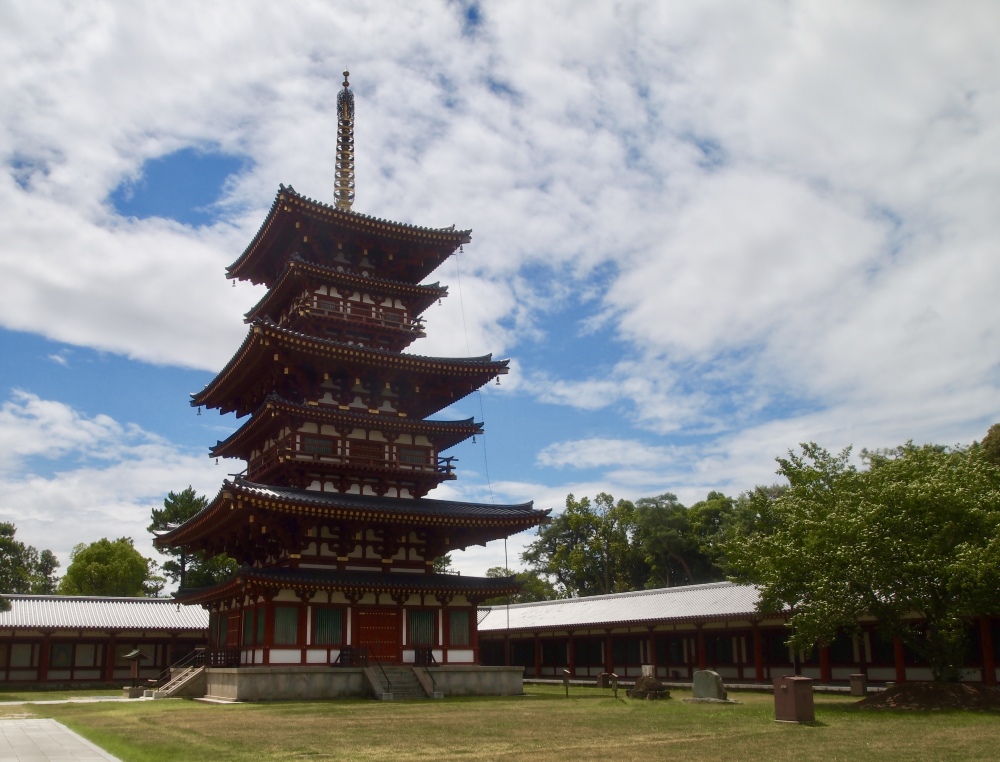
West Pagoda at Yakushiji Temple

Buddha image at Yakushiji Temple

West Pagoda at Yakushiji Temple

Golden Hall at Yakushiji Temple
The Middle Gate stands between the South Gate and the Kondo, or Golden Hall. You can see a hot wind is blowing.

Middle Gate at Yakushiji Temple

Guardian of the Middle Gate

Guardian of the Middle Gate
The Golden Hall at Yakushiji Temple is truly magnificent, especially with those spectacular Buddha statues inside.

Golden Hall at Yakushiji Temple
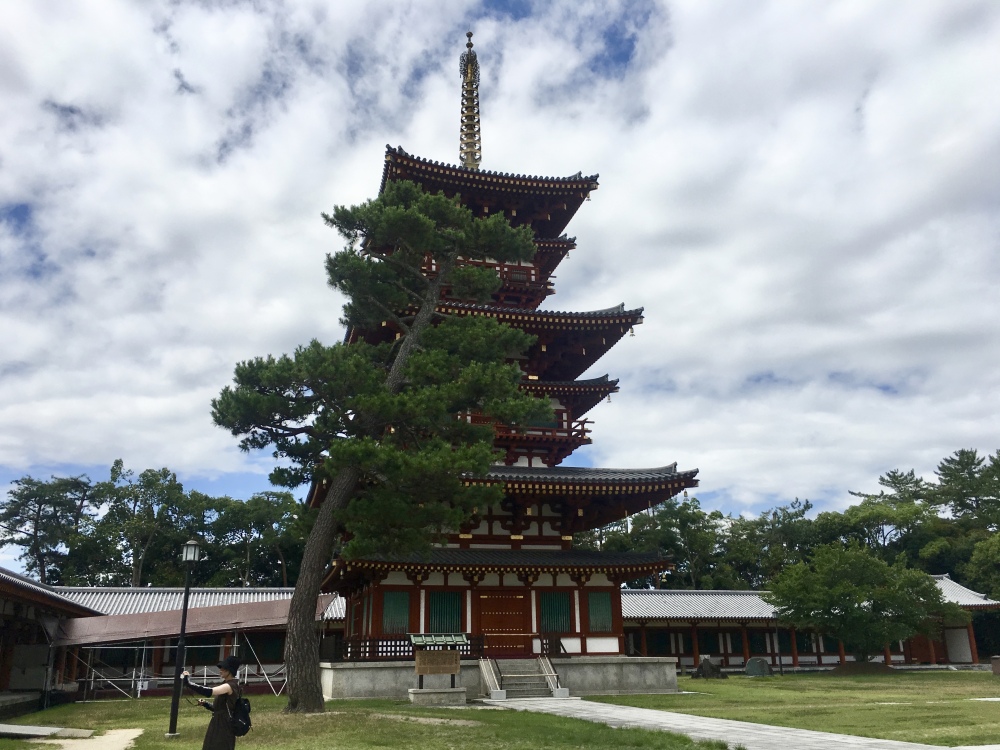
West Pagoda
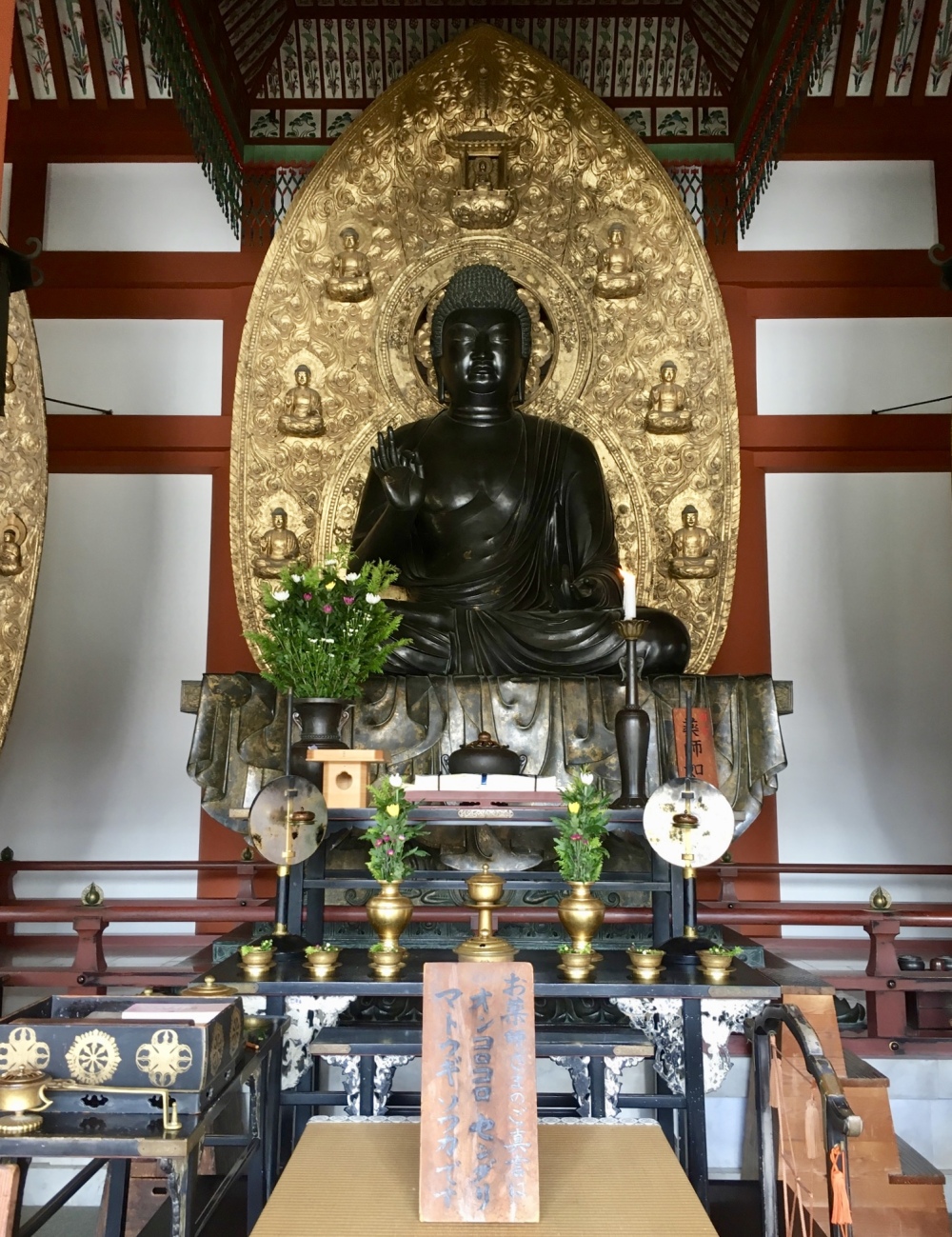
Buddha at Yakushiji Temple
After my visit to both of these fabulous temples and their resplendent Buddha images, I catch bus #70 to return to Nara. Back at the train and bus station, I search inside a big supermarket for kakinoha-zushi, which translates as “persimmon leaf sushi.” The Nara region is famous for this delicacy. I am able to show the name in Japanese to one of the supermarket employees, who points out the package.
Kakinoha is individual pieces of sushi wrapped in persimmon leaf, shown below. You’re not supposed to eat the persimmon leaves. I sit outside on the front stoop of the supermarket with a bunch of other people enjoying this treat, although it’s a little awkward opening up the persimmon leaves and eating them while holding them on my lap.

kaki-no-ha

kaki-no-ha

kaki-no-ha
After I finish eating, I’m on my way by another bus to Kasuga Taisha Shrine, Wakamiya Jinja Shrine, and Kofuku-ji. 🙂
Thursday, August 3: This morning, I take the 10:17 a.m. Shinkansen from Hiroshima to Kyoto, arriving at 11:54 a.m. There, I get on the Nara Line to Nara Station (12:03-12:48). On the train, I sit beside a 34-year-old guy named Zachary who teaches grammar and literature to middle school students at a private school in L.A. He’s going to Nagasaki to make some kind of presentation for the peace ceremony on August 9. We chat for the entire 45 minutes; in Nara, I disembark from the train and am off to find the Hotel Nikko Nara.
After dropping my bags at my hotel, which is a nice one right next to the train station, I stop to eat tempura and rice at a restaurant at the station. There I meet a friendly and talkative Japanese housewife named Hiromi who asks if she can join me. She tells me she’s from Yokohama and has come down here for one day to see two things, one museum in Kyoto and one in Nara. She plans to return home late tonight. She herself has no children but she asks endless questions about my teaching job and says she is embarrassed on behalf of all Japanese people for my misbehaving “I” class.
After lunch, I hop on Bus #2 at Nara Station and I hear a loud: “Cathy!!” I look around to find Christine from Luxembourg, who I met in Nikko last weekend. When we talked about our travel plans in Nikko, I knew that the only place we might intersect was in Nara, but never in a million years did I actually expect to run into her here. What a small world it is sometimes!
She is on her way to Yoshiki-en, a garden that is free for foreign tourists. I am on my way to the Great Buddha, but as the garden is on my way, we explore the garden together. It is sweltering and humid, but we wander around, enjoying the shade offered by little pavilions along the way. There are three unique gardens within Yoshiki-en: a Pond Garden, a Moss Garden and a Tea Ceremony Garden. The Moss Garden has a detached thatch-roof tea house. In the Pond Garden, slopes and curves of the land remaining from the Edo period (17th-19th centuries) blend with the buildings. The garden is a suitable environment for hair moss (Polytrichum), so the whole area is covered with it. The garden, originally the home of the high priest of Tōdai-ji, was laid out in 1918.

Yoshiki-en

Yoshiki-en

Yoshiki-en
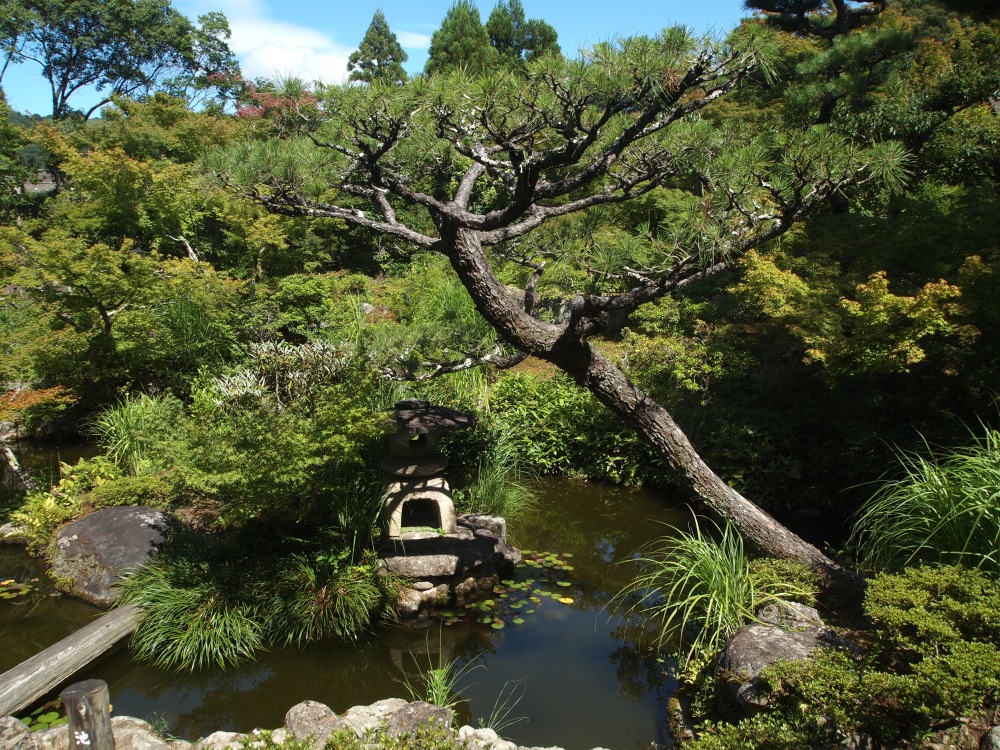
Yoshiki-en
Click on any of the pictures in the gallery below for a full-sized slide show.

Yoshiki-en

Yoshiki-en

tea house at Yoshiki-en

tea house at Yoshiki-en

Yoshiki-en

Yoshiki-en

Yoshiki-en
After we explore the garden, I say goodbye to Christine and make my way to Tōdai-ji, walking through Nara-kōen, a park that is home to about 1,200 deer. The deer are considered National Treasures. In pre-Buddhist times, they were considered messengers of the gods. The deer roam freely throughout the park and won’t hesitate to approach people if they think they can abscond with a few morsels of food.

Nara’s deer
Tōdai-ji, “Great Eastern Temple,” was founded in 728 as a resting place for the Crown Prince Motoi, son of Emperor Shōmu (r. 724-749). The temple was used as the head temple of all provincial Buddhist temples of Japan and grew so powerful that the capital was moved from Nara to Nagaoka in 784 in order to lessen the temple’s influence on government affairs (japan-guide.com: Todai-ji Temple). It is believed the temple was built to consolidate the country and serve as its spiritual focus, but its construction almost brought the country to bankruptcy, according to Lonely Planet Japan.
The temple is famous today for housing the famous Daibutsu (Great Buddha) in the Daibutsu-den Hall of the temple.
I first pass through an outer gate.

approaching Todai-ji
Once through this outer gate, I’m face to face with the world’s largest wooden building, Daibutsu-den Hall. Unbelievably, this structure, rebuilt in 1709, is only two-thirds the size of the original.
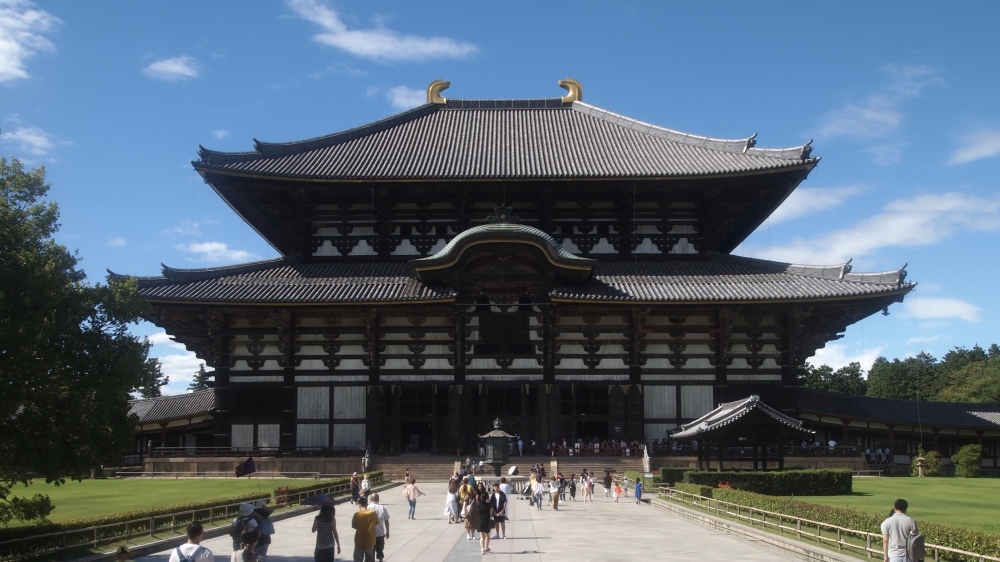
Todai-ji

Todai-ji

Todai-ji

Todai-ji

Todai-ji
The Daibutsu (Great Buddha) inside, originally cast in 746, is one of the largest bronze sculptures in the world. At one time it was covered in gold leaf, quite an impressive sight for Japanese 8th century visitors. The present statue, recast in the Edo period (1603 – 1868), stands 15 meters tall; the seated Buddha represents Vairocana, the cosmic Buddha believed to give rise to all worlds and their respective Buddhas (Lonely Planet Japan), and is flanked by two Bodhisattvas.

Daibutsu

Daibutsu
The Kokuzo Bosatsu, seated to the left of the Daibutsu, is the Bodhisattva of memory and wisdom. Students pray to him for help in their studies, while the faithful pray for enlightenment. Standing to the left of the Daibutsu and the Kokuzo Bosatsu is Komokuten, a guardian of the Buddha. He stands upon a demon (jaki), which symbolizes ignorance, and holds a brush and scroll, which symbolizes wisdom (Lonely Planet Japan).

Daibutsu

Daibutsu

Kokuzo Bosatsu

Komokuten
A pillar with a hole in its base is supposedly the same size as the Daibutsu’s nostril. It is said that those who can squeeze through this opening will be granted enlightenment in their next life (japan-guide.com: Todai-ji Temple). I watch as a boy squeezes through the hole. I guess he will have guaranteed enlightenment!

Hole in Pillar

Hole in Pillar

Hole in Pillar
I always love to check out the ema at every temple, and I find this cute one at Tōdai-ji: “I wish my family won’t be angry at Matthias. Hooray.”

Ema at Todai-ji

Ema at Todai-ji
Seated to the right of the Daibutsu is Nyoirin Kannon, one of the Bodhisattva that preside over the six realms of karmic rebirth.

Nyoirin Kannon

Nyoirin Kannon

Daibutsu
Pindola was one of the sixteen arahats, who were disciples of the Buddha. Pindola is said to have excelled in the mastery of occult powers. It is commonly believed in Japan that when a person rubs a part of the image of Binzuru (Pindola Bharadvaja) and then rubs the corresponding part of his own body, his ailment there will disappear.

Binzuru
The Tōdai-ji grounds are quite verdant at this time of year.

Todai-ji grounds

Todai-ji grounds

Todai-ji grounds
Nigatsu-dō lies to the east of the Great Buddha Hall and up the side of Mount Wakakusa. Nigatsu-dō (which translates to “The Hall of the Second Month”) is a beautiful hall that overlooks the city of Nara and provides a view of its ancient structures. To get to it, I walk through peaceful neighborhoods lined with lanterns, a welcome relief after the crowds at Tōdai-ji.

walking to Nigatsu-dō

walking to Nigatsu-dō

inside cafe at Nigatsu-dō

doors at Nigatsu-dō
I line up with other visitors along Nigatsu-dō’s balcony to absorb the views.

Nigatsu-dō

view of Nara from Nigatsu-dō
The original construction of Nigatsu-dō hall is estimated to have completed somewhere between 756 and 772. Nigatsu-dō was destroyed in 1667 due to a fire. Re-construction of Nigatsu-dō was completed in 1669. In 1944, it was chosen by Japan as one of the most important cultural assets of the country. This sub-temple of Tōdai-ji reminds me of Kiyomizu-dera, which I visited in Kyoto in 2011 (golden pavilions, rock gardens, bamboo groves, and white-gloved train conductors).

roof at Nigatsu-dō

lanterns at Nigatsu-dō

view from Nigatsu-dō

lanterns at Nigatsu-dō

view from Nigatsu-dō

lanterns at Nigatsu-dō
I love all the lanterns at Nigatsu-dō.

Nigatsu-dō

Nigatsu-dō

Nigatsu-dō

Nigatsu-dō

ema at Nigatsu-dō

ema at Nigatsu-dō
Nigatsu-dō is quite majestic sitting high on the hill.

Nigatsu-dō

steps to Nigatsu-dō
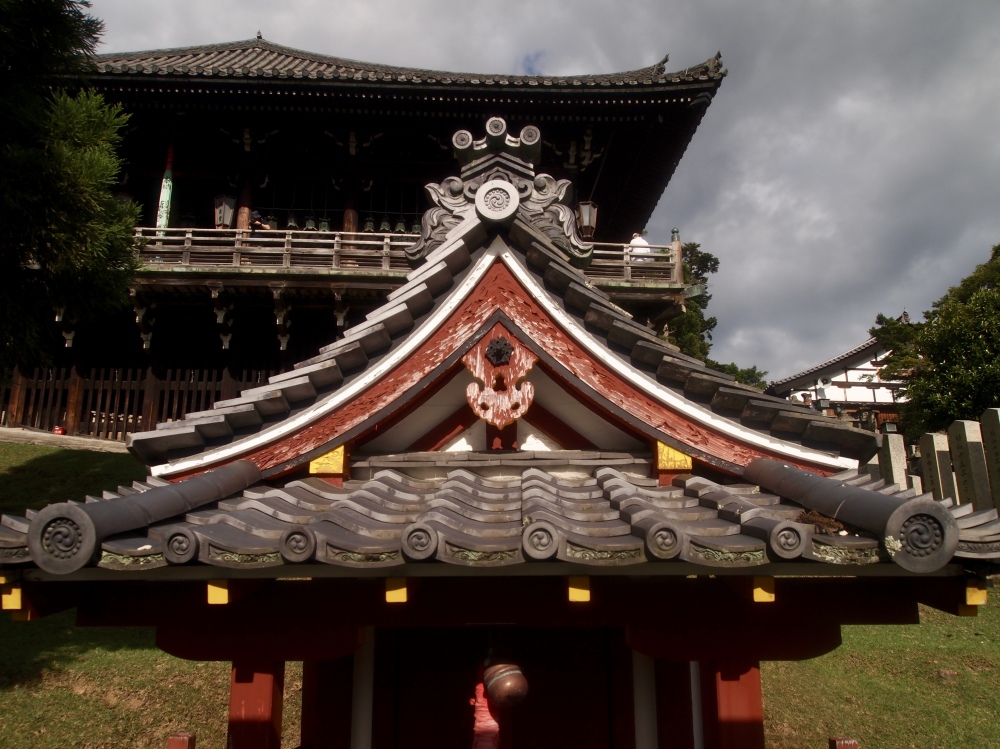
Nigatsu-dō

shrine at Nigatsu-dō

Nigatsu-dō

Nigatsu-dō

Nigatsu-dō

Nigatsu-dō
Nigatsu-dō is best known for Omizutori, a fire and water ceremony on March 12 every year, where huge flaming torches are held out from the temple balcony. The next day, sacred water is drawn from a well under the temple, which is said to have healing properties. The ceremony has been held here without a break since the temple’s founding in 752 (Visit Nara: Nigatsu-do).

Nigatsu-dō
Sangatsu-do Hall is home to a small collection of Nara-period statues.

Sangatsu-do Hall

Sangatsu-do Hall
Tamukeyama Hachimangu is a Hachiman shrine, dedicated to the kami Hachiman, a divinity of archery and war. It was established in 749. Kami, spirits or phenomenon worshiped in the Shinto religion, enshrined here include: Emperor Ōjin, the 15th emperor of Japan; Emperor Nintoku, the 16th emperor; Empress consort Jingū, who ruled beginning in the year 201; and Emperor Chūai, the 14th emperor.

Tamukeyama Hachimangu

Tamukeyama Hachimangu

ema at Tamukeyama Hachimangu

ema at Tamukeyama Hachimangu

Tamukeyama Hachimangu

Tamukeyama Hachimangu

ema at Tamukeyama Hachimangu

Tamukeyama Hachimangu

ema at Tamukeyama Hachimangu

Tamukeyama Hachimangu

Tamukeyama Hachimangu
After leaving Tamukeyama Hachimangu, I make my way back to Tōdai-ji, passing a spiral sōrin, circling Kagami-ike Pond, and finally walking under Nandaimon Gate. Nara’s deer keep me company the whole way.

sōrin at Tōdai-ji

Kagami-ike Pond

Kagami-ike Pond

Kagami-ike Pond

deer of Nara
As I’m leaving Tōdai-ji, I walk through the Nandaimon Gate, a large wooden gate, rebuilt in the 13th century, watched over by two fierce-looking statues. Representing the Nio Guardian Kings, the statues are designated national treasures together with the gate itself.

Nandaimon Gate
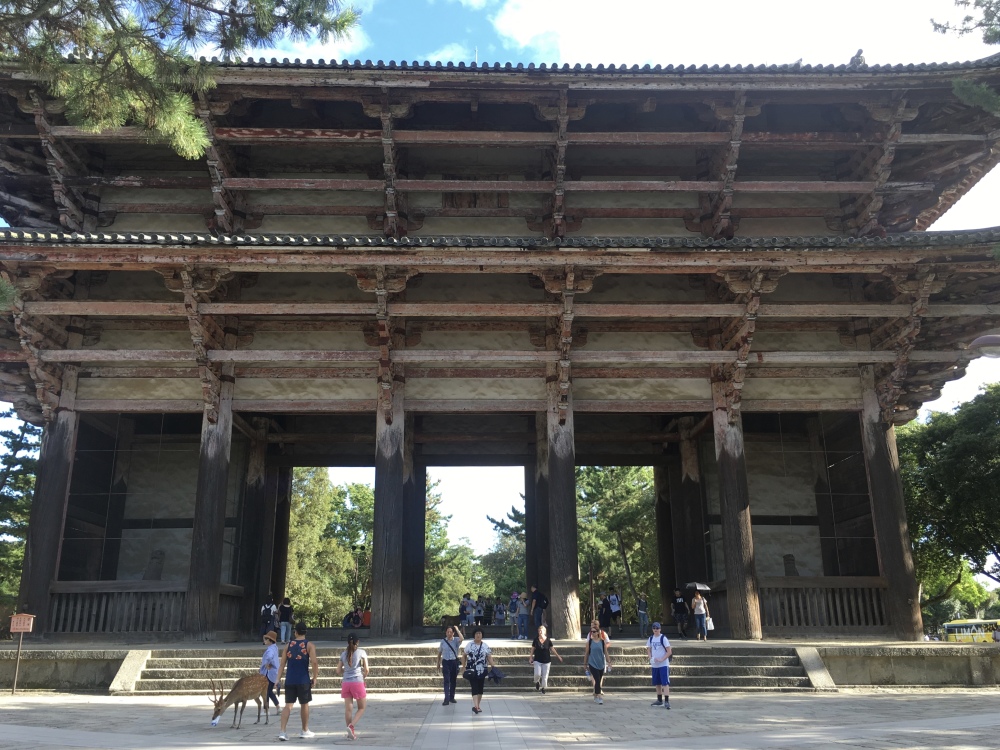
Nandaimon Gate

deer of Nara

deer of Nara
Nandaimon Gate is impressive in its size and ancient grandeur.

Nandaimon Gate
The deer of Nara are everywhere!

deer in Nara

Nara’s deer

deer

deer in Nara

deer in Nara

deer in Nara
Nara’s deer are having a rest near the main gate, undoubtedly perspiring in this sizzling weather.
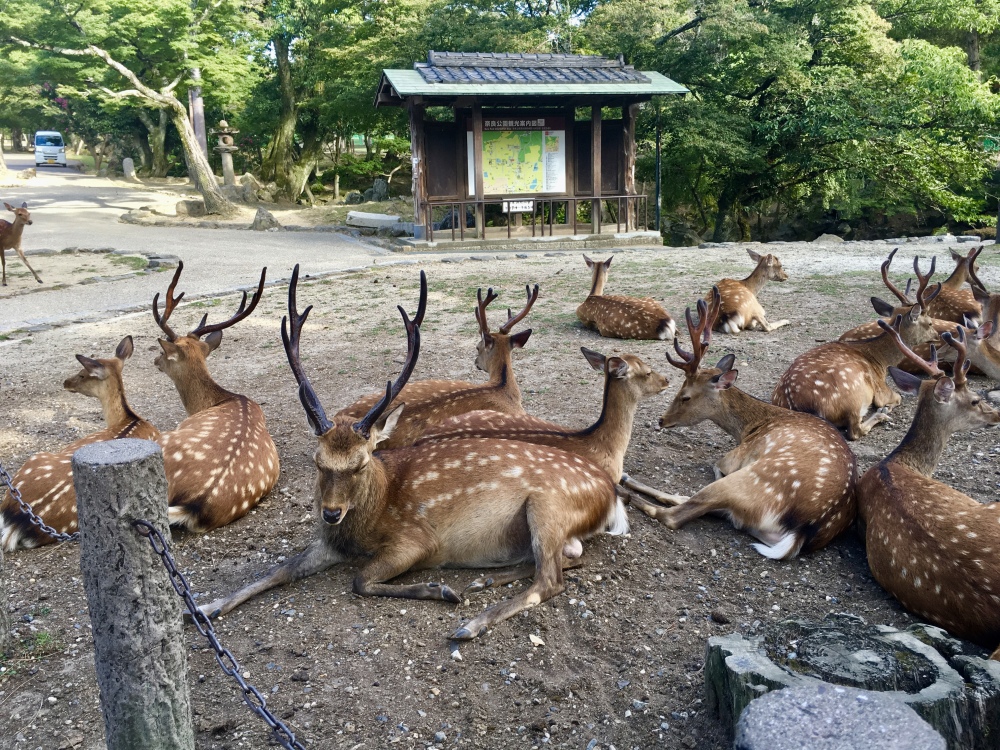
Nara’s deer
After taking a shower back at my hotel, I go into Nara Proper to have a Pizza Margherita at the Mellow Cafe.

mellow cafe
On the way back to my hotel, I stop for an ice cream with a little deer on top. It provides a bit of welcome relief from the heat

pizza at mellow cafe

me with ice cream in Nara
Tomorrow, I’ll explore more of Nara.
Steps today: 15,835 (6.71 miles)
















































































































































































































































